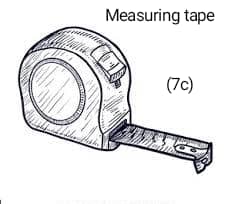[7/31, 10:05 AM] Solution: *NABTEB METAL WORK THEORY*



1a)
(i) Scriber:
(i)Wear safety glasses to protect eyes from flying metal particles
(ii)Hold the scriber firmly and avoid applying too much pressure, which can cause it to slip and injure your hand
(ii) Try square:
(i)Handle the try square with care to avoid accidents and injuries
(ii) Ensure the try square is properly secured to the workpiece to prevent it from slipping and causing harm
(iii) File
(i)Use a file handle to prevent hand contact with the file teeth, which can cause injury
(ii)Work in a well-ventilated area to avoid inhaling metal particles and dust
(iv) Chisel:
(i) Wear safety goggles and gloves to protect eyes and hands from flying particles and sharp edge
(ii) Strike the chisel with a ball-peen hammer, not a regular hammer, to avoid damaging the chisel or causing injury
(1b)
(i) Ferrous metal:
A metal that contains iron, such as steel, cast iron, and wrought iron. Ferrous metals are prone to rusting and corrosion.
(ii) Non-ferrous metal:
A metal that does not contain iron, such as aluminum, copper, bronze, and brass. Non-ferrous metals are generally more resistant to corrosion than ferrous metals.
(1c) TABULATE
(i) High carbon steel: Ferrous metal
(ii) Mild steel: Ferrous metal
(iii) Bronze: Non-ferrous metal
(iv) Brass: Non-ferrous metal
(v) Pig iron: Ferrous metal
[7/31, 10:05 AM] Solution: *NABTEB METAL WORK*
(2a)
(i)Headstock
(ii)Tailstock
(iii)Carriage
(iv) Bed
(2aii)
(i)Headstock:
(i)Holds the workpiece between centers or in a chuck
(ii)Transmits power to the workpiece
(iii)Supports the workpiece during turning operations
(ii)Tailstock
(i)Supports the workpiece at the opposite end of the headstock
(ii)Provides additional stability and rigidity
(iii)Can be used to drill or ream holes
(iii)Carriage
(i)Moves along the bed to position the cutting tool
(ii) Supports the cutting tool and toolpost
(iii)Allows for precise control of the cutting tool’s movement
(iv) Bed
(i)Provides a solid foundation for the lathe
(ii)Supports the headstock, tailstock, and carriage
(iii)Guides the movement of the carriage
(2b)
(i) Clearance fit:
A type of fit where there is a deliberate clearance or gap between two mating parts. This allows for easy assembly and disassembly, and is often used for parts that require movement or rotation.
(ii) Transition fit:
A type of fit where the tolerance between two mating parts is such that the parts can be assembled with a slight force, but not enough to cause interference. This fit is used for parts that require a precise fit, but still need to be assembled and disassembled.
(iii) Interference fit:
A type of fit where the tolerance between two mating parts is such that the parts must be forced together, resulting in a strong and rigid joint. This fit is used for parts that require high strength and stability, such as engine parts or gearboxes.
[7/31, 10:05 AM] Solution: *NABTEB METAL WORK*
(7a)
(i)Ruler
(ii) Caliper
(iii) Micrometer
(iv) Vernier scale
(7b)
(i)Handle measuring tools with care to avoid damage or breakage, which can cause injuries
(ii) Ensure proper zeroing and calibration of measuring tools to avoid inaccurate measurements.
(iii) Avoid touching or handling measuring tools with dirty or oily hands, as this can compromise accuracy and damage the tools.
[7/31, 10:05 AM] Solution: *NABTEB METAL WORK*
(5a)
Drilling is a machining process that involves creating a hole in a workpiece using a rotating cutting tool called a drill bit. The drill bit is attached to a drill machine or hand drill and is fed into the workpiece under controlled conditions, removing material and creating a cylindrical hole.
(5b) TABULATE
(i)Bench work refers to manual or hand operations performed on a workbench to fabricate, assemble, repair, or modify objects.
(ii) A workbench is a sturdy table or surface designed to support and facilitate various tasks, operations, and projects. .
(5b)
Coming……



